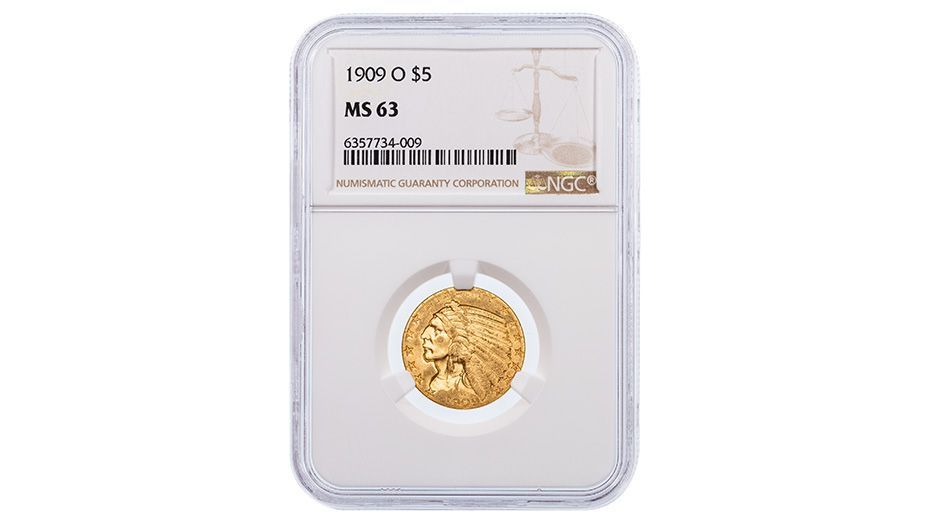1909-O Indian Head Gold Half Eagle NGC MS63
Jack McNamara's Live Auction Featured Coin
Thursday, September 28th, 2023
Join our auction live at 5 PM PST / 8 PM EST
on Directv 222 and Dish 85/224
Our Private Advisory Coin Team has early access to our weekly auction coins. Pre-bidding is now open for this week's stunning selections. Call our Private Advisory Coin team at (800) 778-0624 to join our auction bidding. Your Personal Advisor can accept your confidential bid for this coin.
________________________________________________________________

- Mintage: 34,200
- NGC Population: 8/9
- PCGS Population: 9/12
- CU Price Guide: $150,000
- Finest Known: MS66 (1) – Last traded for approx. $650,000 in 2014. Expected to cost roughly $900,000 today.
- The 1909-O Half Eagle is the final gold coin produced at the New Orleans Mint; operations ceased later that year.
- 26th U.S. President and the youngest president ever, Theodore Roosevelt, sought to restore beauty to United States coinage.
- Roosevelt commissioned the help of many renowned sculptors and artists of his day, including his dear friend Augustus Saint-Gaudens.
- Through Saint-Gaudens’ masterwork, Roosevelt was determined to reimagine all U.S. coin designs that he deemed of “atrocious hideousness.”
- Saint-Gaudens first major project with Roosevelt was creating Roosevelt’s Inaugural Medal in 1905. This medal is possibly one of the greatest numismatic achievements in history.
- Not only did he manage to fully express the imagination of President Roosevelt in exceptional detail but this event was truly the beginning of the Renaissance of American Coinage.
- The reverse design used on the 1905 Inaugural Medal featuring what has been deemed as a “defiant eagle” is the same design subsequently used on the gold eagle and half eagle once reworked in the early 1900s.
- Following the Inaugural Medal, Saint-Gaudens went on to redesign the gold double eagle and gold eagle before he unfortunately met an untimely death in 1907, cutting his and Roosevelt’s dream short.
- Presumably, his next project would have been the third largest gold denomination, the five-dollar half eagle. Although, his passing meant he was no longer able to continue his outstanding work on additional U.S. coin designs, his legacy was upheld by Roosevelt and other famous artists.
- One such individual being American sculptor Bela Lyon Pratt, an understudy of Augustus Saint-Gaudens, who with the assistance of another brilliant mind, William Sturgis Bigelow, brought an entirely new concept to United States Coinage by implementing an unfamiliar technique on the new half eagle beginning in 1908.
- The technique Pratt used on the new gold half eagle was inspired by ancient Egyptian hieroglyphs and Greek coins, sharing the same passion for these pieces as President Roosevelt.
- Instead of the typical raised design above a flat field, Pratt opted to impress the design into the metal creating a sunken relief or incuse design. Pratt used this concept on the gold quarter eagles introduced in 1908, as well.
- No other regular-issue U.S. coin would implement this sunken-relief technique making the quarter and half eagles produced from 1908 to 1929, unique in American coinage.
- As for the design itself, Pratt continued to innovate by featuring an Indian chief in ceremonial headdress with the word LIBERTY above and the date below. This would mark the first time a design of an actual Indian was featured on a standard issue United States coin.
- Alluded to earlier, the reverse features a majestic American eagle, the same used on Saint-Gaudens ten-dollar gold eagle and nearly identical to the one on Roosevelt’s Inaugural Medal.
- Throughout the Indian Head Half Eagle series there are four dates that standout among the rest; the 1908-S $5, 1911-D $5, and 1929-P $5, however the pinnacle date in the series without question is the 1909-O $5!
- There are many reasons for its grave importance, the first being that the 1909-O $5 is the last gold coins struck by the New Orleans Mint and the only O-Mint Indian Head Half Eagle.
- It also, happens to be extraordinarily rare in Uncirculated condition. Over 85% of all surviving pieces show signs of circulation, allowing for no more than 15% of all surviving examples to exist in Mint State condition.
- Comparatively, the 1929-P $5 has the fewest surviving examples in all conditions at a little over 600 pieces. However, approximately 90% of these pieces exist in uncirculated condition.
- The icing on the cake for the 1909-O $5 is of course the fact that it also happens to be the lowest minted date in the entire Indian Head Half Eagle series at 34,200 coins struck.
- Data from the table above was pulled earlier this year from NGC & PCGS census reports. It clearly illustrates the immense scarcity of the 1909-O $5 in MS63 and finer condition, especially when compared to its peers.
- Nearly half a decade has passed since the last time a 1909-O $5 in MS63 condition has publicly traded. Even still, the last MS63 example sold for roughly the same price as the current opening bid for this lot, $115,000.
- To summarize the current specimen is the final New Orleans gold issue, the only O-Mint Indian Head Half Eagle, featuring an innovative incuse design unique to the Indian Head Half & Quarter Eagle, the lowest minted Indian Head Half Eagle and is in unbelievable MS63, starting well below Collector Universe Price Guide.








